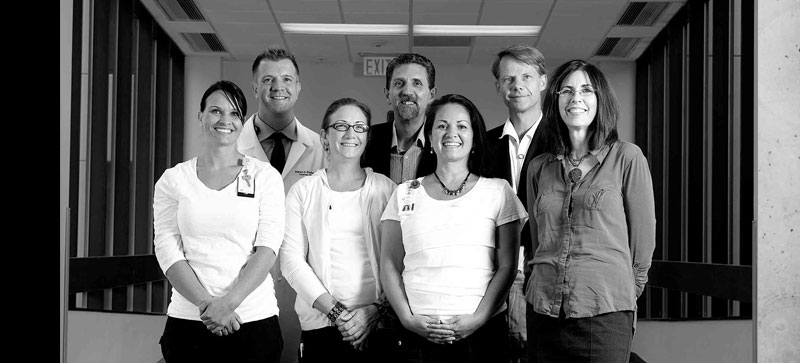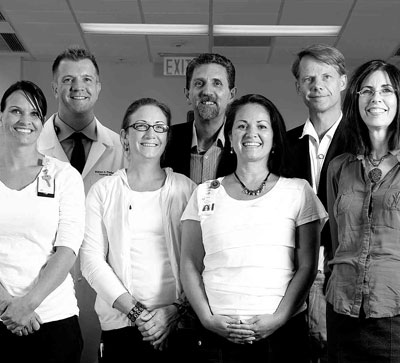Central Line Infections: The Zero Tolerance Crew

The entire staff of University of Utah Hospital’s Intermediate Care Unit worked on a process to eliminate central line–associated bloodstream infections.
Representing the unit here are (front row, from left to right) Carrie Charlesworth, R.N., B.S.N., C.C.R.N., nurse manager, Stevi Gire, R.N., B.S.N., nurse educator, Trell Inzunza, R.N., B.S.N., clinical nurse coordinator, and Jeanmarie Mayer, M.D., associate professor of internal medicine. Back row, (from left to right) Robert Pendleton, M.D., associate professor of medicine and chief medical quality officer, Boaz Markewitz, M.D., associate professor of internal medicine, Frank Drews, Ph.D., M.S., associate professor of psychology.
Nearly 15 years after the landmark Institute of Medicine report “To Err Is Human” laid out a comprehensive plan to reduce preventable medical errors, tens of thousands of patients continue to die each year from infections they catch in hospitals. For hospital epidemiologist Jeanmarie Mayer, M.D., and critical care pulmonologist Boaz Markewitz, M.D., even one of these deaths is unacceptable. “Zero harm is the only reasonable goal,” says Markewitz, “even if you don’t think you can reach it.”
As part of their commitment to zero harm in health care, they set out to eliminate central line-associated bloodstream infections (CLABSIs). By re-engineering the central line dressing change process on the University Hospital’s Intermediate Care Unit, they’ve proven that Lean error-proofing techniques can be as effective in heath care settings as they are in Toyota factories. For more than two years, they haven’t had a single CLABSI on their unit. They changed the system. And the culture. “We can’t have the mindset that even one preventable infection is okay,” says Mayer.
How did they do it? By first acknowledging that to err is human—especially in a fast-paced hospital environment where constant distractions are the norm. They asked every nurse and medical assistant on the unit to make a grim prediction: how the next patient would be harmed. Staff resisted at first, not wanting to point fingers or expose problems. But as monthly quality improvement meetings were replaced with daily safety rounds, people started talking and sharing their concerns and their solutions for fixing problems.
With the leadership of Frank Drews, Ph.D., M.S., associate professor of psychology, they identified and addressed the “human factors” that caused infections. Nurse Manager Carrie Charlesworth, R.N., B.S.N., C.C.R.N. and her staff in the Intermediate Care Unit staff were enthusiastic in piloting the new foolproof dressing changing kit that built in the realities of their work environment. Individual pouches hold supplies needed for a single step, along with clear, concise, and specific instructions. The pouches are ordered, guiding nurses to perform the procedure in the safest sequence. “The process improvements we’ve made have been driven by our frontline team members, not the people at the top,” says Mayer. “Our nurses are the people who are doing it every day. They are the ones who should be making the decisions.”
Initially, many practitioners on other units were insulted by the very idea of it. As highly trained thinkers, they felt they didn’t need anyone or anything to walk them through a simple process that they learned in nursing school. “But there are so many more important ways to use high-level thinking. So why use it on something that can be made rote?” said Mayer. And who can argue with the data, as in zero harm?



